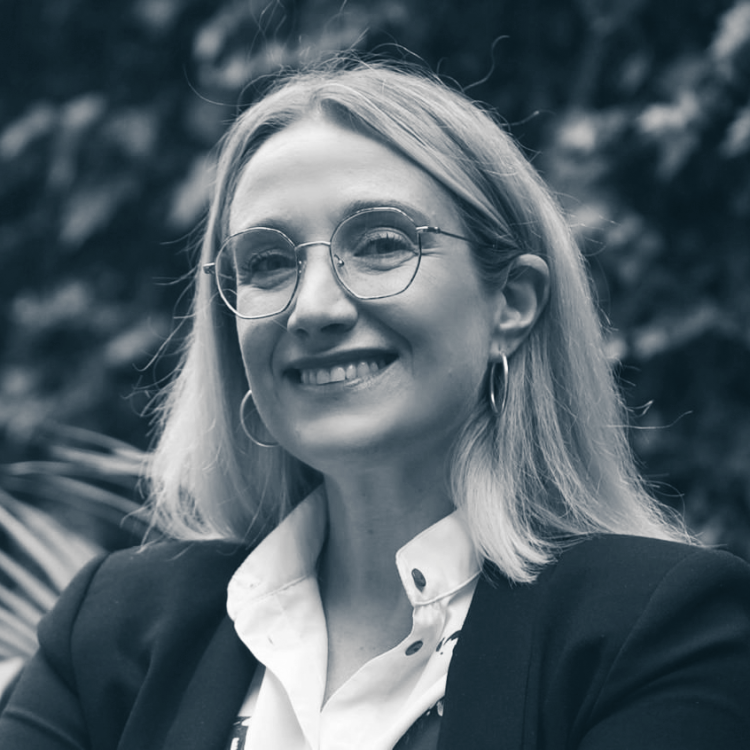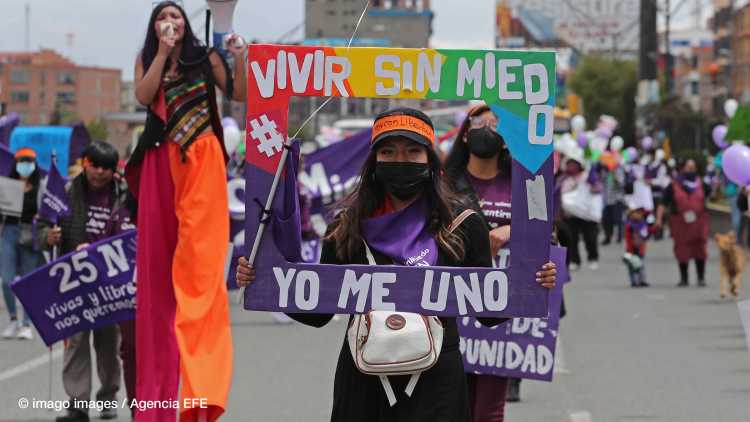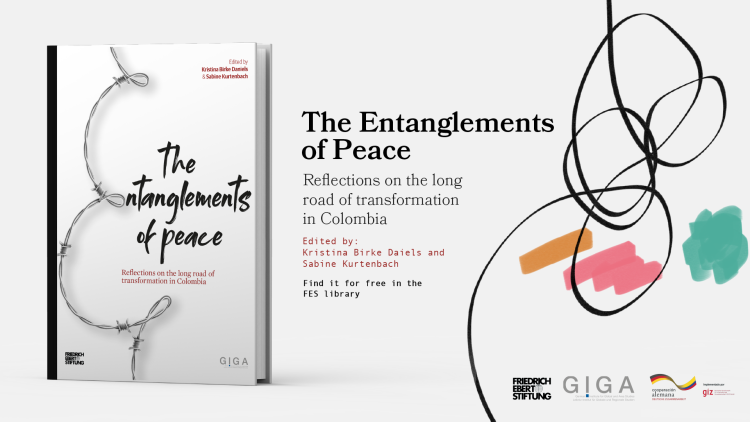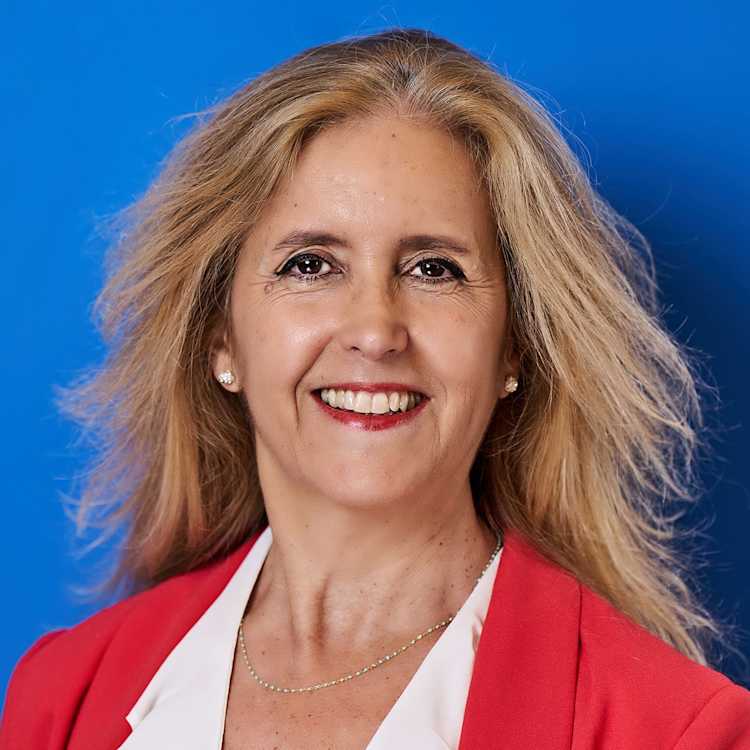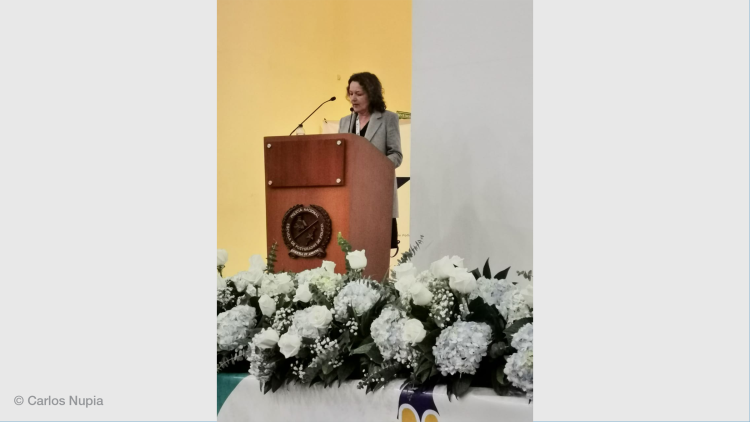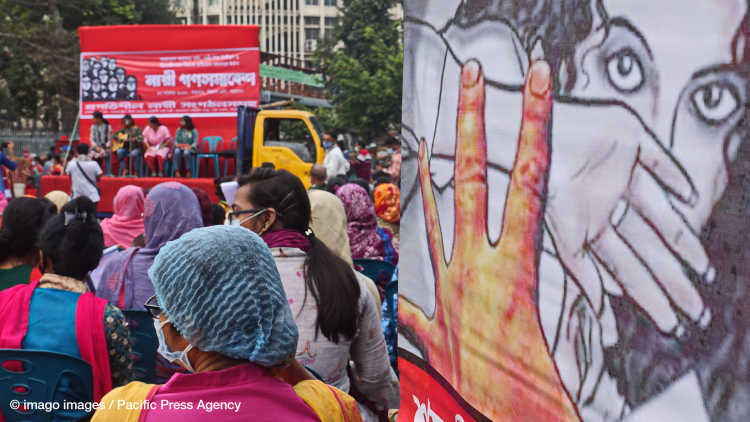- Home
- Publications
- GIGA Focus
- Pandemic, Protest, and Petro Presidente: Rescuing Colombia’s Peace
GIGA Focus Latin America
Pandemic, Protest, and Petro Presidente: Rescuing Colombia’s Peace
Number 3 | 2022 | ISSN: 1862-3573
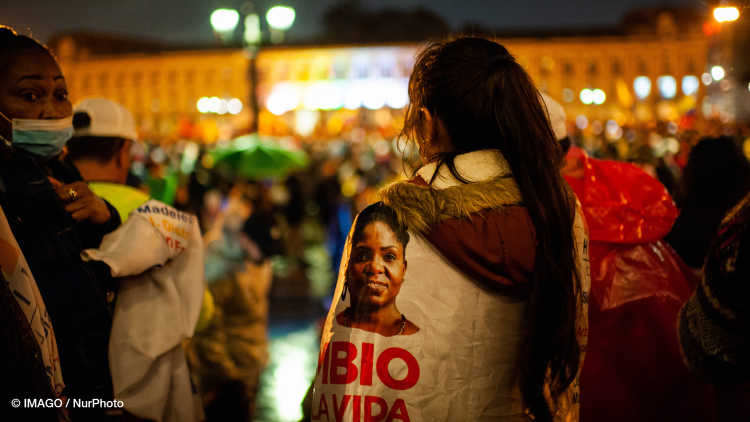
Colombia elected a new progressive government on 19 June. While the COVID-19 pandemic did not play a direct role in the campaign, it has deepened both structural problems as well as pre-pandemic trends such as high levels of social inequality, citizen distrust regarding state institutions, and increasing violence in certain regions of the country. While these social disparities led to a call for change by different groups, reducing violence will be a key policy test for the new government.
COVID-19 hit Colombia at a delicate time. A comprehensive peace agreement had been signed in 2016, but the elections of 2018 brought the forces that had run on an anti-agreement platform into government. A half-hearted implementation of the accord resulted, which together with increasing citizen dissatisfaction led to mass protests at the end of 2019.
In the wake of the pandemic’s onset, around six million Colombians fell into poverty. Despite some social policies such as the solidarity income (ingreso solidario), in many fields the state retreated from the provision of public services – in contrast with an increase in repressive measures, as for instance in the pursuit of coca eradication.
After a short decrease in collective forms of violence due to lockdown policies, pre-pandemic patterns resumed. In peripheral and border zones, armed actors strategically leveraged the pandemic to increase their control over illicit enterprises and local populations.
The entanglement of deteriorating socio-economic conditions, increasing violence, and an extremely unpopular government opened the door to the election of the first left-leaning president in Colombia’s history, Gustavo Petro. The new government offers the historic opportunity to save the peace agreement and initiate the profound changes Colombia desperately needs.
Policy Implications
External actors need to support the reform agenda. Particularly, the implementation of the structural changes established in the peace agreement as well as reform of the country’s security institutions. While the latter are ignored in the peace accord, doing so is a necessary condition to promote trust in the state and to contain violence by means other than repression. In addition, new economic policies for greater social inclusion and the mitigation of climate change are urgent topics on the agenda too.
A Fragile Post-Accord Peace
The comprehensive peace agreement signed between the government and the FARC-EP (Fuerzas Armadas Revolucionarias de Colombia – Ejército del Pueblo) guerrilla group was lauded internationally but highly controversial in Colombia. In 2016, a referendum to legitimise the accord led to a first major crisis, as abstention was high and a slight majority voted no. Some provisions and wordings were changed, with a final version of the accord signed in November of that year. Nevertheless, the anti-accord coalition then won national elections in 2018. While implementation was a binding policy for 12 years, the government of Iván Duque put the brakes on that and undermined some of the accord’s transformative provisions such as those related to agrarian reform, measures for the inclusion of historically marginalised communities and intersectional gender equality, transformation of the country’s drugs policy towards a more inclusive and less repressive approach, as well as to its transitional justice mechanism (Jurisdicción Especial para la Paz, JEP) (Birke Daniels and Kurtenbach 2021).
The demobilisation of the FARC-EP was successful, but their retreat prompted a new phase of competition between violent non-state armed actors in the zones they used to control. Different forces such as the remaining guerrilla group ELN (Ejército de Liberación Nacional), dissident factions of the FARC, as well as a variety of organised crime syndicates aimed to control drug production and other illegal economies (mining, human trafficking, illegal timber logging) further to the strategic corridors for their commercialisation plus local populations, too. Therefore, violence – which had been at historically low levels in 2018 – started to flare up once more. As Figure 1 below shows, violent events tend to concentrate in those poor and peripheral areas of the country most affected by armed conflict in the past and where state presence remains precarious (Gutiérrez Sanín 2020). Likewise, the comparison between national and subnational levels of violence displayed in Figure 2 below makes evident that homicide rates in the 170 municipalities prioritised for implementing the peace accord – the so-called PDET (Programas de Desarrollo con Enfoque Territorial, Territorially Focused Development Plans) municipalities – are above average in relation to the rest of the country.
Figure 1. Regional Variation in Violence in Colombia, 01.01.2019–05.03. 2020
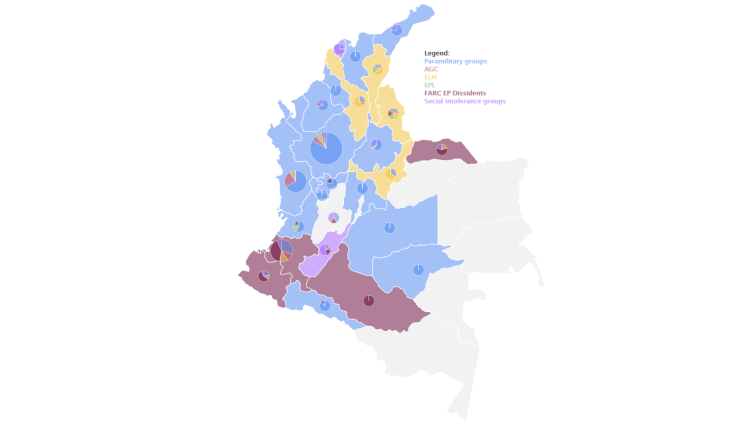
Source: Authors’ own elaboration, based on the CINEP/PPP Human Rights and Political Violence Database 2022.
Figure 2. Homicide Rate in Colombia 2012–2020, National and in PDET Municipalities
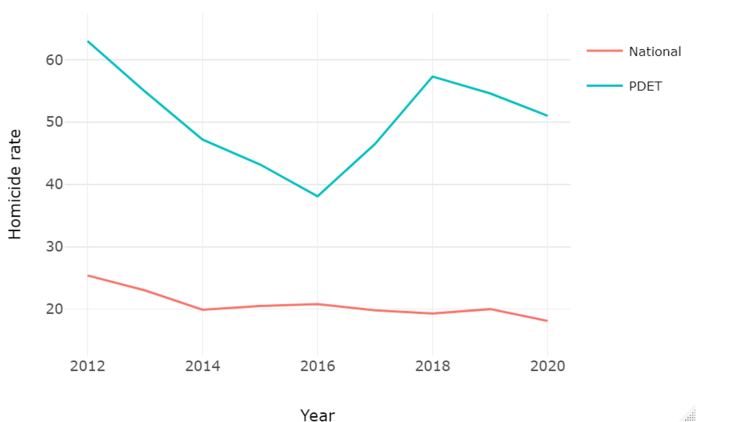
Source: Authors’ own elaboration, based on data from the Foundation Ideas para la Paz FIP 2021.
The killing of social leaders and human rights defenders has spiked over the last few years. According to the non-governmental organisation INDEPAZ, there were 279 and 310 assassinations of social leaders in 2019 and 2020 respectively; meanwhile, 171 assassinations were reported in 2021. In addition, INDEPAZ recorded 192 former FARC combatants killed or disappeared between 2019 and 2021.
Amid this transitional phase out of war, and linked to the political opening unleashed by the peace agreement, Colombia experienced a process of vibrant social mobilisation. A protest movement encompassing diverse sectors within Colombia society and a wide range of demands mobilised against the incumbent right-wing government. Starting on 21 November 2019, labour unions, youth, and other marginalised urban and rural sectors organised a nationwide strike (Borda 2020).
President Duque questioned the motives and legitimacy of the protestors and ordered the deployment of anti-riot units and military personnel on the streets. The government’s violent response fuelled further outrage and stronger citizen support for the demonstrations. Facing increasing political pressure and mounting unpopularity, Duque proposed the establishment of a “grand national conversation.” Yet, no significant progress ensued. While the protest movement lost impetus and mobilisation subsided towards the end of the year, citizen discontent continued simmering. The government’s announcement of new reforms in line with those that had partly motivated the protests in the first place led to the expectation of a resurgence of social unrest in 2020.
… and Then Came COVID-19
Colombian authorities registered the first case of COVID-19 on 6 March 2020. As of June 2022, meanwhile, the country reported about six million confirmed positive cases and almost 140,000 related deaths to date (see Figure 3). To contain the pandemic, the government would implement strict lockdowns, quarantines and curfews, as well as measures of fiscal and social policy. From March to August 2020, national as well as local government decreed some of the harshest lockdown measures and mobility restrictions worldwide. Restrictions and closures were later gradually lifted, mostly driven by their devastating economic impact and the impossibility to follow mobility restrictions and stay-home orders for large parts of the population dependent on a daily income.
Figure 3. Number of Reported COVID-19 Cases in Colombia (Per Day), 01.03.2020–30.04.2022
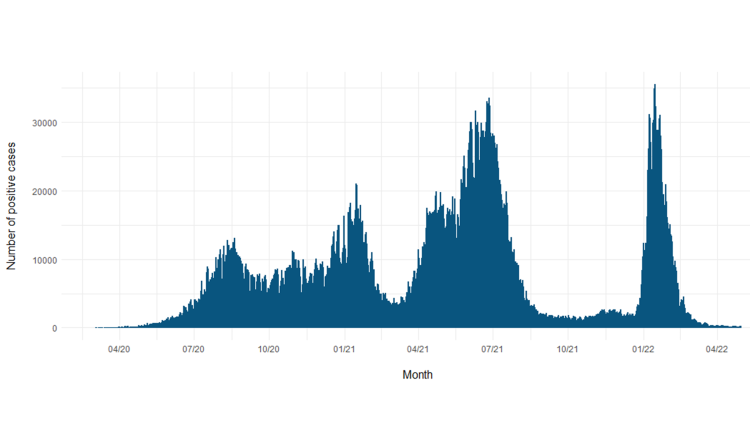
Source: Authors’ own elaboration, based on data from the Johns Hopkins Coronavirus Resource Center 2022.
The Colombian government undertook measures to increase the healthcare system’s capacity and to cushion COVID-19’s socio-economic impacts, including the expansion of social-assistance programmes and the creation of cash transfers for vulnerable households (Programa Ingreso Solidario). Nevertheless, intensive care units and hospitals were stretched beyond capacity during the peaks of COVID-19 waves. Despite the social assistance, people from disadvantaged socio-economic sectors – especially the estimated 45 per cent of the labour force making their living in the informal sector (DANE 2022) – had to return to the streets out of sheer necessity.
Schools and care facilities for smaller children remained closed for almost two years, with access to online learning being extremely unequal. This not only led to high numbers of school dropouts but has lowered an entire generation’s life goals and expectations. Overall, the pandemic has erased the gains made from years of poverty reduction in Colombia, with women being by and large more affected than men. According to the national statistics agency DANE (2022), monetary poverty increased from 35.7 per cent in 2019 to 42.5 per cent in 2020. This figure amounts to 3,551,522 people having fallen into poverty. Extreme monetary poverty, in turn, went from 9.6 per cent in 2019 to 15.1 per cent in 2020 – the latter equivalent to some 2,781,383 people. Although DANE’s statistics for 2021 show a reduction in poverty, it remains at higher levels than 2019 – with 39.3 per cent monetary poverty and 12.2 per cent extreme monetary poverty respectively.
In regard to the dynamics of violence, theoretically an external shock or an emergency such as the COVID-19 pandemic can have a range of effects. It can worsen structural factors underpinning the (re)production of violence, ensuing socio-economic crises can exacerbate violent conflicts, while non-state armed actors can seize the opportunity to strengthen their control over illegal markets and populations. Such shocks can, as well, have no major effects in instances where mitigating policies are successful, or – and this is a rare development – they can promote cooperation between different actors to fight the emergency first as they postpone long-running struggles over other issues.
In the case of Colombia, the pandemic has had an ambivalent impact. On the one hand, we observe a short-term decrease in episodes of violence (Figure 4). The ELN heeded the call of the United Nations Secretary-General to lay down arms during the pandemic by declaring a unilateral ceasefire for April 2020. Lockdown and mobility restrictions likewise contributed to a brief decline in homicide rates and conflict fatalities. On the other hand, COVID-19 has exacerbated long-standing problems such as poverty, inequality, and weak social safety nets. Containment measures also prompted a retreatment of state institutions crucial to service provision, further feeding popular discontent and distrust vis-á-vis those institutions. Taken together, the political and socio-economic impacts of the pandemic have strengthened the structural conditions (re)producing violence and fuelling social unrest. New opportunities for both state and non-state armed actors to exploit the crisis and advance their strategic interests in contested areas would emerge, too. For instance, the Duque government took advantage of the situation to strengthen coca-eradication programmes even in violation of the will and well-being of local communities.
Figure 4. Armed Conflict Events in Colombia, 01.01.2019–31.12.2021
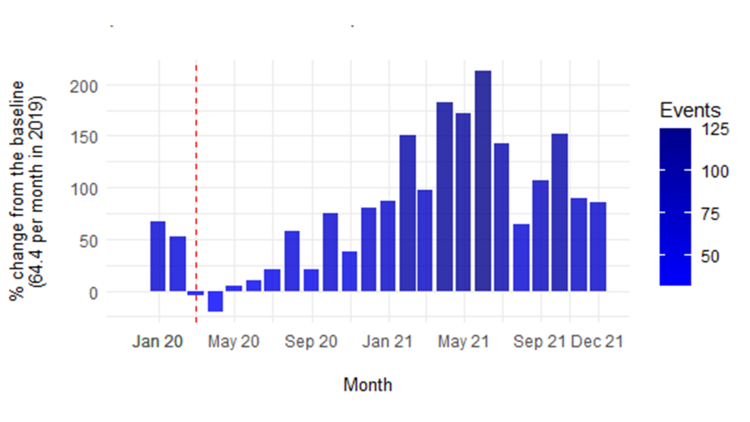
Source: Authors’ own elaboration, based on Armed Conflict Location & Event Data Project (ACLED) data.
Notes: Armed Conflict Events = violence against civilians, battles, and explosions/remote violence; dotted red vertical line indicates the official beginning of the COVID-19 pandemic in Colombia.
In rural areas, armed actors instrumentalised the pandemic to increase their control over strategic territories such as the border with Venezuela or those important to drug production. Coca crops again became an important means of survival for rural populations. The convergence of economic crisis and the widespread COVID-19-related closure of schools amid the intensification of armed conflict provided a fruitful context for youth recruitment by different non-state armed groups. Community workers and local social leaders observe that, amid the lack of viable alternatives and acute economic vulnerability, persuasion is equally or indeed even more important than force when it comes to youth recruitment into armed groups. According to local accounts in Norte de Santander, armed groups organised clandestine parties, sports events, and beauty contests to lure youngsters suffering from the restrictions of the lockdown into their ranks.
The socio-economic effects of the pandemic, in combination with the policies adopted and reforms announced by the government in response, triggered, as noted, the re-intensification of protests across the country (International Crisis Group 2021). Between the end of April and early June 2021, an unprecedented 1.5 million people took to the streets in both urban and rural areas demanding social and political change (see Figure 5). The peaceful protests escalated through the interaction of small groups of violent protesters, vandalism, looting, and the harsh repression the police and its anti-riot force (ESMAD) unleashed in response. Roadblocks both within and between Colombia’s cities caused disruption to the provision of basic goods and services, negatively affecting the economy – with Cali being a major hotspot of the protests. Over time, however, mobilisation declined due to fatigue setting in and the increasing problems of everyday affairs.
Figure 5. Protest and Riots in Colombia, 01.01.2020–31.12.2021
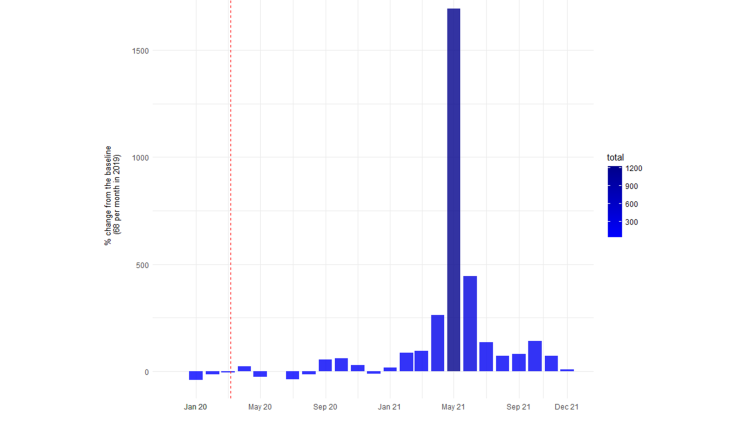
Source: Authors’ own elaboration, based on ACLED data.
Note: Dotted red vertical line indicates the official beginning of the COVID-19 pandemic in Colombia.
The reaction of state security forces to the protests was extremely violent. The NGOs INDEPAZ and Temblores (2021) reported 75 associated deaths – 44 of them attributed to the police – further to thousands of attacks on civilians, featuring among other things sexual violence and eye injuries. Growing concerns about the violent crackdown prompted the visit of a commission from the Inter-American Commission on Human Rights (CIDH-IACHR) in early June 2021. In its report, the Commission noted that the state response was characterised by excessive and disproportionate use of force and urged the Colombian government to comply with its legal obligations to protect the democratic right to protest.
Against this background, Colombia entered an electoral cycle. The presidential and congressional elections of 2022 would be shaped by several key factors. On the one hand, the increased citizen discontent and ongoing social unrest. Citizen grievances were channelled through the opposition firmly in the direction of President Duque; their demands called for structural transformation and a reformulation of the social contract. At the same time, the ongoing realignment and reshuffling of armed actors after the peace accord intensified violence further to strengthening illegal markets and criminal governance, too. A survey by Cifras & Conceptos and Colombia’s National University (2022) shows that the three issues the country’s populace held dearest prior to the elections were unemployment (50 per cent), corruption (51 per cent), and security (50 per cent) respectively.
The Call for Change
The election results would lay bare Colombians’ yearning for profound change. In the congressional elections (18 March 2022), the domestic populace voted for the most progressive Congress in history. While the traditional parties (Liberal Party, Conservative Party) managed to preserve a significant number of seats, the Pacto Histórico – a leftist progressive coalition – came close to being the largest group in Congress (see Figures 6 and 7 below). However, both the Senate and the House of Representatives are highly fragmented; the new government will have to find allies if it is to pass legislation.
Figure 6. Electoral Results 2022 for the Senate (108 seats)
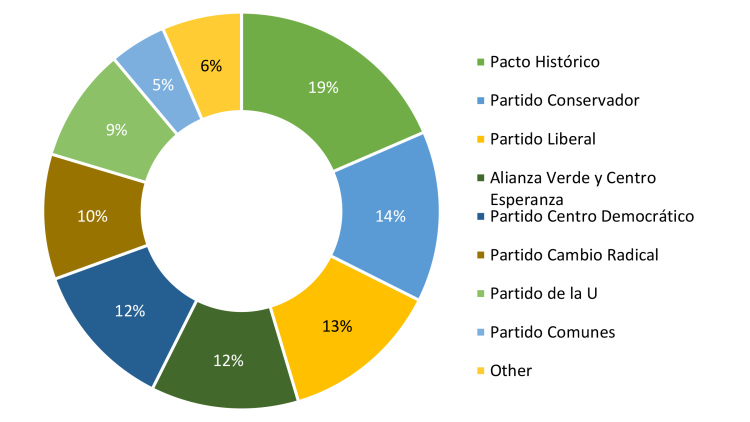
Source: Authors’ own calculation, based on National Registry of Colombia (NRC) (preliminary results).
Figure 7. Electoral Results 2022 for the House of Representatives (188 seats)
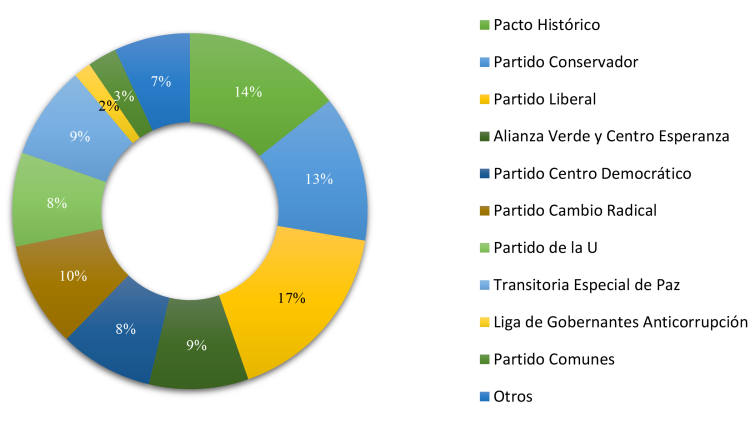
Source: Authors’ own calculation, based on NRC (preliminary results).
The unpopularity, meanwhile, of the outgoing Duque and the fact that former president Álvaro Uribe did not stand as a candidate led to a disastrous electoral result for their party, the Centro Democrático. The party lost five seats in the Senate and 16 in the House of Representatives. Perhaps the party’s decline is best illustrated by the inability it encountered to field its own candidate for the presidential elections. In turn, the Centro Democrático supported Fedérico Gutiérrez, former major of Medellin and candidate from the so-called Coalition Equipo por Colombia.
The results of the congressional elections foreshadowed the outcome of the looming presidential ones. Petro and his running mate Francia Márquez – from the Pacto Histórico – and Gutiérrez and Rodrigo Lara – from the right-centrist coalition Equipo por Colombia – led pre-election polls. The formula of Petro and Márquez achieved smooth passage to the second round of voting. But, contrary to expectations, Gutiérrez lost his ticket to Rodolfo Hernández, a rich businessman and former mayor of Bucaramanga, and his largely unknown vice-presidential candidate, Marelen Castillo.
Both Petro and Rodríguez ran under the banner of change and the rejection of traditional politics and elites. Interestingly, in the survey cited above – whose fieldwork was finished five days prior to the second round of the presidential elections – 43 per cent of respondents declared that they believed Petro would implement his proposed plans once in government, while only 23 per cent thought Hernández would do so. Additionally, Petro’s campaign built on a broad platform running the whole gamut from social inclusion, to a more progressive economic development model, to the full implementation of the peace agreement, to climate change. Hernández’s programme was far more limited: other than emphasising the combat against corruption as its main goal, it remained vague in content.
Most of the country’s conservative and traditional political forces united behind Hernández. Pre-election surveys showed a technical stalemate for the second round, and many expected a repetition of the 2018 elections – when large segments of society united in an “all against Petro” platform, giving victory to Duque. The time leading up to the ballot was fraught with distrust towards the electoral authorities, negative campaigning vis-à-vis respective opponents, and acute fears of fraud. Apprehension regarding the electoral process was certainly not unfounded; irregularities in the congressional elections had led to disputes over the vote count. After denouncing errors in the initial tally, Petro’s Pacto Histórico obtained around 750,000 more votes in the final count. Parties affected by these discrepancies demanded a full recount, claiming that the Pacto Histórico was involved in voter fraud. However, their demands did not go any further as they failed to present evidence of the alleged fraud and Colombia’s national legislation does not include a stipulated procedure for the recount of the total ballot. Besides these concerns about the electoral process, statements made by civilian and military authorities against Petro, including some from President Duque and the General Commander of the Armed Forces, raised further worries about the possible disregard of the results if the Pacto Histórico’s candidate was to win.
Despite the many concerns, the run-off vote counting progressed quickly and without problems. One hour after the polls closed and with 98 per cent of the votes counted, it was evident that Petro and Márquez had won. The official result gave them 50.44 per cent of the vote versus Hernández and Castillo’s 47.03 per cent thereof. Participation was the highest since 1998, with 58 per cent of those eligible casting their vote. Bogotá, other large cities, and the peripheral regions of Colombia – where all the unresolved structural problems of violence, inequality, and lack of civil livelihoods accumulate – were key for the results seen; Petro and Márquez also were clearly ahead among women, youth, as well as indigenous and Afro-Colombian communities.
Following the elections, three developments stand out offering signs of hope for meaningful change:
There was no questioning of the legitimacy of Petro’s victory: Hernández conceded quickly, and also the outgoing president Duque and the heads of major Colombian business associations congratulated Petro without delay. Even ex-president Uribe sat down with Petro to discuss the major problems Colombia faces.
Diminishing polarisation: Despite the catastrophic result for the Centro Democrático candidates and the verbal confrontation during the campaign, Colombia was never as polarised as some would claim and others might have hoped. A representative survey on Colombian’s perceptions of peace showed that most people regard respect, justice, and tranquillity as the most important elements of peace (Kurtenbach and Palop 2021: 59). In his first speech as president-elect, Petro invited his opponents into a “National Agreement” and promised that victory would not lead to vengeance.
A second chance for peace: The implementation and reinvigoration of the peace accord will be a key goal of the new government. Petro’s acceptance speech revolved around the topic of peace, reconciliation, and dialogue. This is important to mitigate at least some of the Colombian right’s fears of a leftist government. He also reiterated the commitment to peace-building during the presentation of the final report of the Truth Commission on 28 June 2022, in lieu of the notably absent Duque.
Give Peace a (Second) Chance? Challenges for the New Government
The “Opposition Statute” – enacted in 2018, and part of the developments brought about the peace accord – demands political parties declare their position towards a new government (supporting, opposing, independent). Shortly after the elections there was an unprecedented bandwagon effect regarding cooperation with the new president. Not only centre-left parties such as the coalition of Alianza Verde and Coalición de la Esperanza opted for support; even traditional establishment parties such as the Liberal Party (whose leadership had campaigned for Hernández) declared they would cooperate with the new government, too. Until today (early July), only the Centro Democrático has declared its opposition to the latter. It remains to be seen whether this is part of the emerging national consensus on necessary reforms or if it is tactical support to get some ministries or other quotas and advantages in budget provisions (in Colombia, called mermelada). The social movements that were key for the Pacto Histórico’s success have high expectations on real change and will closely monitor the Petro government’s policies.
The six main challenges the government (and the country as a whole) faces can be summarised as follows:
Peace and security: Implementation of the main transformative provisions of the peace agreement, namely the stalled provisions regarding agrarian reform and the protection of demobilised ex-combatants, social leaders, and human rights defenders. As well, the reform of the security apparatus – police and armed forces – that was neglected in the peace accord but included as one of the main recommendations in the Truth Commission’s final report.
Illicit economies: Changing the national and international prohibition regime to reduce drug production as well as other criminal activities such as illegal mining, human trafficking, animal smuggling, and illegal trade. Illegal economies have increased during the pandemic by providing at least some survival livelihoods; they are also highly intertwined with violence and a stronghold of anti-reform elites.
Corruption: This was not only the main banner of Hernández’s campaign; a referendum in 2018 – initiated among others by the current mayor of Bogotá, Claudia López – got over 12 million votes despite falling short of the necessary quorum. Corruption remains a pressing problem throughout the country. Before he was elected, Petro voiced the idea of an international commission on corruption and impunity modelled after the Guatemalan CICIG.
A new economic development model: Colombia’s economy relies on oil and the extraction of other natural resources whose prices are highly volatile and only generate a limited number of jobs. To provide decent work and livelihoods for all, and to include youth, women, ethnic, and Afro-Colombian communities, as well as LGTBIQ+ populations politically and socially, the country needs a new development model including for the first time ever an industrial policy. At the same time, this could be an important contribution to combatting climate change.
Social policies: Petro has vowed to make social policy more equal, accessible, and inclusive. The platform of his earlier campaigns particularly stressed quality education for all; in this year’s campaign the focus was on health. In addition, his running mate as well as the country’s social movements are demanding the prioritisation of combatting hunger, poverty, and gender inequalities. His proposed agricultural minister, Cecilia López, has in the past advocated making care work one of the driving forces of the economy and productivity – a truly innovative proposal worldwide.
Venezuela: Last but not least, Colombia’s relations with its direct neighbour need a reset as the conflicts in both countries are heavily intertwined (Birke Daniels, Stollreiter, and Wegner 2021). In their respective campaigns, both Petro and Hernández declared that they would reopen the border and re-establish communication with the Nicolás Maduro government. Beyond restoring bilateral trade, the high number of Venezuelan migrants in the country is what drives Colombia’s interest in a negotiated management of the present crisis.
The new government will need to advance reforms in all these fields despite dire state finances. Therefore, implementing its proposals for progressive tax reform will be the toughest test of its operability. The COVID-19 pandemic has increased public debt to unprecedented levels, around 61 per cent of gross domestic product (Central Bank of Colombia 2022). Hence, managing high expectations in a political situation that remains delicate despite the mentioned bandwagon effect calls for sensitive and careful compromise.
International Support Is Still Needed
The international community played a major role in the implementation of the peace accord and the support of important reforms such as the transitional justice system (Sistema Integral de Verdad, Justicia, Reparación y No Repetición, SIVJRnR) and Colombia’s policy towards Venezuelan migrants. Fundamental reforms are still pending, and the advent of a new government may provide a historic window of opportunity. Germany is a key ally regarding the JEP, and its Agency for International Cooperation (GIZ) operates its largest programme for peace-building support globally in Colombia. International actors such as Germany, the European Union, and the UN should not only continue but intensify their support and align with the new government’s reform agenda. The German Bundestag passed a resolution on 7 July 2022 calling for the continuation of significant support (financially and technically) for peace-building and reform in Colombia. Leyner Palacios, Afro-Colombian human rights activist and member of the Truth Commission, made an urgent call for international support at the report’s presentation in Berlin, in early July 2022.
However, some reforms (such as in the security sector) may also encounter strong national as well as international resistance. The United States and its “Plan Colombia” have been the main driver behind the build-up of the latter’s armed forces, and traditional drug policy remains a key bipartisan topic in the two countries’ relations. The new government will have to carefully navigate internal and international power relations as well as donor’s reform priorities and approaches if it wants to deliver on its promise of genuine change.
Acknowledgement
Field work for this GIGA Focus was possible thanks to a grant by the Volkswagen Foundation for the project COVID-19 and the Dynamics of (Post-)War Violence: Lessons from Colombia and Syria and the cooperation with the office of the Friedrich Ebert Foundation in Colombia (Fescol).
Footnotes
References
Birke Daniels, Kristina, Susanne Stollreiter, and Katharina Wegner (2021), Vorschläge zur Konfliktlösung in Kolumbien und Venezuela, Brüssel, Berlin: Friedrich-Ebert-Stiftung EU-Büro, Friedrich-Ebert-Stiftung Referat Lateinamerika und Karibik, Februar¸ accessed 18 July 2022.
Birke Daniels, Kristina, and Sabine Kurtenbach (eds) (2021), Entanglements of Peace. Reflections on the Long Road of Transformation in Colombia, Bogotá, Washington: FESCOL, accessed 18 July 2022.
Blavatnik School of Government, University of Oxford (2022), Oxford COVID-19 Government Response Tracker, accessed 28 June 2022.
Borda, Sandra (2020), Parar para avanzar. Crónica del movimiento estudiantil que paralizó Colombia, Bogotá: Crítica.
CIDH-IACHR (2021), Observaciones y recomendaciones visita de trabajo a Colombia, accessed 11 July 2022.
Cifras & Conceptos, and National University of Colombia (2022), Encuesta: Fortaleza y debilidades de la democracia en Colombia, accessed 11 July 2022.
DANE (2022), Pobreza monetaria y pobreza monetaria extrema, accessed 28 June 2022.
Central Bank of Colombia (2022), Boletín de Indicadores Económicos, July, accessed 18 July 2022.
Gutiérrez Sanín, Francisco (2020), ¿Un Nuevo Ciclo de la Guerra en Colombia?, Bogotá: Penguin Random House Grupo Editorial.
INDEPAZ (2022), Observatorio de Derechos Humanos y Conflictividades, accessed 24 June 2022.
INDEPAZ, and Temblores (2021), Cifras de la violencia en el marco del paro nacional 2021, accessed 11 July 2022.
International Crisis Group (2021), The Pandemic Strikes: Responding to Colombia’s Mass Protests, Latin America Report No. 90, Brussels, Bogotá, accessed 14 July 2022.
Kurtenbach, Sabine, and Pau Palop (2021), National Peace, in: Kristina Birke Daniels, and Sabine Kurtenbach (eds) (2021), Entanglements of Peace. Reflections on the Long Road of Transformation in Colombia, 49–63.
General Editor GIGA Focus
Editor GIGA Focus Latin America
Editorial Department GIGA Focus Latin America
Regional Institutes
Research Programmes
How to cite this article
Birke Daniels, Kristina, Viviana García Pinzón, and Sabine Kurtenbach (2022), Pandemic, Protest, and Petro Presidente: Rescuing Colombia’s Peace, GIGA Focus Latin America, 3, Hamburg: German Institute for Global and Area Studies (GIGA), https://doi.org/10.57671/gfla-22032
Imprint
The GIGA Focus is an Open Access publication and can be read on the Internet and downloaded free of charge at www.giga-hamburg.de/en/publications/giga-focus. According to the conditions of the Creative-Commons license Attribution-No Derivative Works 3.0, this publication may be freely duplicated, circulated, and made accessible to the public. The particular conditions include the correct indication of the initial publication as GIGA Focus and no changes in or abbreviation of texts.
The German Institute for Global and Area Studies (GIGA) – Leibniz-Institut für Globale und Regionale Studien in Hamburg publishes the Focus series on Africa, Asia, Latin America, the Middle East and global issues. The GIGA Focus is edited and published by the GIGA. The views and opinions expressed are solely those of the authors and do not necessarily reflect those of the institute. Authors alone are responsible for the content of their articles. GIGA and the authors cannot be held liable for any errors and omissions, or for any consequences arising from the use of the information provided.




